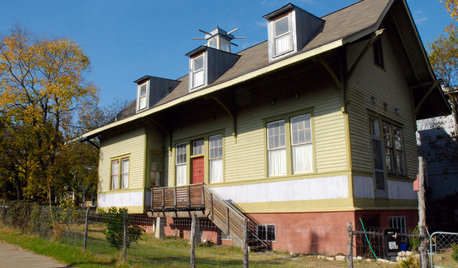Hybrids Good; Heirlooms Bad
carolyn137
15 years ago
Related Stories

HOUZZ TOURSMy Houzz: Color and Heirlooms Combine in a Welcoming Bungalow
Inherited furniture mixes with bright hues in a 1921 Dallas home that embraces the neighborhood and modern life
Full Story
PETSHow to Help Your Dog Be a Good Neighbor
Good fences certainly help, but be sure to introduce your pup to the neighbors and check in from time to time
Full Story
DECORATING GUIDESDinner and a Good Book: 12 Double-Duty Dining Rooms
Create your own library-inspired reading room by pairing a dining table with bookshelves
Full Story
ECLECTIC HOMESHouzz Tour: Good Vibes for a Hollywood Couple in Laurel Canyon
Actor Ian Harding and artist Sophia Hart’s personalities shine in a house nestled in the trees
Full Story
GARDENING GUIDESThe Poop Scoop: Enrich Your Soil With Good Old Manure
Get over the ick factor already — this natural super-ingredient for soil has so many benefits, you'll wonder why you ever went chemical
Full Story
FEEL-GOOD HOMEInherited Pieces: Embrace the Approach That Works for You
How you remember and honor loved ones through heirlooms is your decision alone
Full Story
HOUZZ TOURSMy Houzz: From Train Depot to Family Home in Texas
Sleeping in a train station isn't normally an enviable affair — unless it's a remodeled 4-bedroom beauty filled with family heirlooms
Full Story
HOUZZ TOURSMy Houzz: Going Heavy on the Metal for Industrial-Style Beauty
Steel and iron pieces mix with antiques and heirlooms in an eclectic Netherlands home
Full Story
HOUZZ TOURSMy Houzz: A Hilltop Family Home in Santa Cruz
Couple draws dream home inspiration from 'A Pattern Language' in thoughtfully placing windows, nooks and heirlooms
Full Story
RUSTIC STYLEHouzz Tour: A Modern Ranch Shines in the Alberta Foothills
A mix of family heirlooms, rustic details and Scandinavian style infuses a family’s weekend home in Canada
Full StorySponsored



lionheart_gw (USDA Zone 5A, Eastern NY)
anney
Related Discussions
Can you plant heirloom seeds(pumpkins) next to or near hybrids?
Q
Heirloom and Hybrid Melons
Q
Well, I see the difference in hybrid vs. heirloom! lol
Q
Hybrid F1, Hybrid F2, Heirloom
Q
greenmulberry
catman529
HoosierCheroKee
remy_gw
mulio
carolyn137Original Author
mulio
zucchini
anney
HoosierCheroKee
zebraman
LandArc
anney
HoosierCheroKee
containerted
HoosierCheroKee
anney
sillius
anney
anney
sillius
corrie22
HoosierCheroKee
anney
jsvand5
fusion_power
carolyn137Original Author
carolyn137Original Author
mulio
fusion_power
anney
vera_eastern_wa
carolyn137Original Author
tom8olvr
remy_gw
marylandmojo
trudi_d
mulio
marylandmojo
yummykaz
HoosierCheroKee
zebraman
yummykaz
HoosierCheroKee
lazy_gardens
anney
zebraman
digdirt2